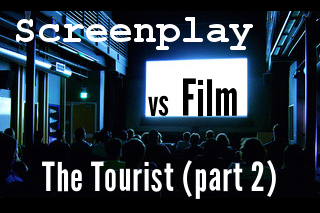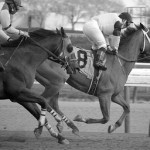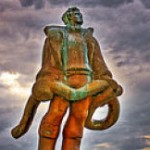Today’s post is a continuation of Screenplay vs Film: 8 Screenwriting Tips from the Tourist. If you haven’t read it, you may want to check that out first before continuing on to the rest of the screenwriting tips from this slow-burning thriller. As always, if you have movies you’d like to see analyzed in this Screenplay vs Film series, please say so in the comments!
And now for the rest of the tips, starting with:
Screenwriting Tip #4: Make use of iconic settings
A repeating theme of Scribe Meets World has been to choose your settings wisely. It cropped up in Guy Ritchie’s action-adventure Sherlock Holmes and in the ultra-successful comedy, The Hangover. In both posts, I encouraged you to choose a setting rich in texture and objects that your characters could make use of — either to escalate the tension or to generate laughs.
If you’ve taken that advice to heart and chosen the most super-awesome setting for your scene…make sure you take advantage of it! In the screenplay draft of The Tourist, Elise follows Alexander’s instructions, boards the Orient Express and selects Frank as her prey.
Maybe I’m biased because Murder on the Orient Express is one of my favorite books (and movie), but I think it’s one of the most iconic trains EVER. And it didn’t seem like the Tourist script really took advantage of that fact. I could’ve missed a key detail, but it seemed to me that the action on the Express felt like it could’ve taken place on any old train in any old country.
In the movie, Elise boards a TGV (Train a Grande-Vitesse or high-speed train) from Paris to Venice. The train’s speed caused a ticking time bomb right at the beginning of the movie, as Paul Bettany’s character, Inspector John Acheson, raced to decipher clues and head off Elise and Frank at the Venice train station. Plus, we got to see some very nice lush backdrops as the train sped through the European countryside. In other words, the setting was utilized to the fullest to advance the plot and develop the atmosphere.
It’s not enough to choose a great setting. You’ve got to make use of that setting’s features to really make your screenplay sparkle.
Screenwriting Tip #5: Movement is key
One of the best shows in television, the West Wing, can only be described as talky. And having two people discuss legislative bills and political maneuvering is certainly not visually interesting–even if it is in the White House, and even if the dialogue is written by Aaron Sorkin, arguably the best dialogue-writer in the industry.
But Sorkin rarely had two characters squished together in an office. More often than not, he had them on the move. Deep in conversation, CJ Cregg, Sam Seaborn, Leo McGarry et al would walk between the maze of West Wing cubicles, up into the press room, or down the hall towards the Oval Office…where they generally had to sit down and shut up until the president asked for their input.
It was just walking, that’s all, but it made all of these scenes more interesting to watch on screen–solely due to the movement.
In The Tourist screenplay, an important conversation between Frank and Elise took place while the two of them were sitting at a poolside cafe table. And it was so dull in comparison to the stand-off they had in the movie which took place at a very elegant Venetian ball. Why? The ball had tons of movement.
The elegance of the ball also added to the overall luxurious tone of the movie, not to mention it was a great external representation of Elise’s feelings for Frank, since she’s dancing around the issue so to speak…but the best part of choosing the ball as the place to vent their feelings was the movement it generated.
There’s one special circumstance where this is really hard to pull off–and that’s if your scenes take place in an office (and not a large sprawling one with several components like the one in the West Wing). If that’s the case, do your best. At the very least, try to have one character DOING something besides talking within that tiny office to generate a little bit of movement.
I never got into the US version of The Office (probably because I watched one episode of the original British version and couldn’t understand a single word Ricky Gervais said), but they’ve clearly been successful portraying the office environment. Studying a few Office episodes might provide a couple of tips in this arena. If you’re an Office fan and can think of some bits of activity the characters do to increase the movement in the scene, please share in the comments!
Screenwriting Tip #6: Commit
A one-word screenwriting tip admittedly isn’t very helpful, so let me elaborate. As I mentioned in Part I of screenwriting tips from The Tourist, when I first read the screenplay, it seemed to have two different tones.
One was in the vein of a Bourne-style thriller with lots of action, gun fights, and high-speed car chases. This was intermixed with scenes that were less intense, more luxurious and languid. And yes, while the action in your screenplay should have valleys as well as peaks, this was something different.
The movie, however, got rid of superfluous pistol whipping and replaced the SUVs in the high-speed chase with canal boats, which are achingly slow, but perfect for the overall tone of slow-burning intrigue. They also upped the luxury factor by adding an elegant Venetian ball (mentioned in screenwriting tip #5), and filling Elise’s hotel room at the Hotel Danieli with expensive clothing and jewels. In other words, they committed to a less intense, more luxurious old-fashioned type of thriller.
Amateur screenplays often have the same problem, especially if their writers started their scripts with one premise, only to find that their draft turned into something else. If you think that may apply to your screenplay, first ask yourself, what is the tone of my movie?
Try to generate 3-5 adjectives that describe your tone. Then go through your screenplay draft, scene by scene, and evaluate your settings and plot developments. Do they enhance and support your overall tone? Can you apply one–or all–of the adjectives you wrote down to each scene? If not, choose another backdrop or way of unfolding your story events, until all of your script choices support the tone of your story world.
Screenwriting Tip #7: Gadgets aren’t everything
In both the screenplay draft and the movie version of The Tourist, all the story events came to a head at Alexander’s Italian villa, although there are some major differences between the two. One of them has to do with the contents of his safe, which every single character is interested in.
In the screenplay, the safe contained…drum roll…a flash drive. Yes, a flash drive. Not very exciting or visually interesting like, let’s say, bundles of unmarked bills (cliche as they are) or crown jewels mined in India. The other drawback to the flash drive is that the characters had to stop and load it into a computer before they could find out what information it held, which can slow down the momentum of your story. (Since this was after the climax, it didn’t put a spanner in The Tourist’s momentum, but if used earlier, it could very well have.)
Technology is pervasive and clearly here to stay.
While cell phones, flash drives, and social media may be true to life, it doesn’t mean that your story events have to hinge on using them.
Instead of cell phones, put your characters in the same room with each other. The same goes for social media. Why poke someone virtually, when you can jab and spar with them in real life?
As for the flash drive, this is how the movie handled it: they replaced it with a check. A check isn’t that visually interesting, you say? Well, I agree with you…but there is something intriguing about finding only one item in this heavily guarded safe. A check too is so old-school and classy, it’s very much in keeping with the mysterious Alexander–and the overall old-fashioned sensibilities of the movie.
For another example of how to handle technology, check out screenwriting tip #2 in 10 Screenwriting Tips from RED.
Screenwriting Tip #8: Make your hero heroic
Alexander has gone through a lot to become Frank. He’s spent thousands of dollars getting a facial reconstruction. More importantly, he’s spent half the movie almost getting killed by Russian goons. He deserves a heroic moment at the end!
In the screenplay draft of The Tourist, he gets one, but it’s not heroic enough. Read it below and see for yourself. (Remember Cara=Elise, Ackerman=Acheson and Demidov=Shaw).
INT. ALEXANDER’S VILLA – NIGHT
Frank bursts through the front door. Races to the steps without hesitating…
INT. ALEXANDER’S VILLA, PENTHOUSE – NIGHT
Cara lies on her side at Demidov’s feet. Blood trickles from the side of her mouth.
Her eyes are clouded with fear and pain as she views the room half-askew. Then they suddenly come nto focus as she sees…
A figure walks into the room. FRANK.
He stand motionless in the doorway, surprisingly calm.
Demidov turns.
DEMIDOV
(leans down to Cara)
Good news. He loves you.
Demidov’s men take Frank by either arm and roughly drag him forward.
Cara lifts her head with an effort.
CARA
That’s not Alexander Pearce.
Demidov ignores her and walks up to Frank.
DEMIDOV
You know, Mr. Pearce, I thought I was finished with this sort of thing. But in your case, I’ve been forced to make an exception.
He holds out his hand and one of his THUGS gives him a PISTOL and a SILENCER.
CARA
He is NOT Alexander Pearce!
Demidov begins screwing the silencer onto the barrel.
The thugs push Frank to his knees.
But he’s barely paying attention to them. His eyes are locked on Cara.
She meets his gaze. For a moment, it’s as if nothing else in the world exists but the two of them.
He may only be a hapless tourist, but he loves her. He’s the one here, willing to give up his life to save hers.
CARA (CONT’D)
Oh Frank…I’m so sorry.
FRANK
Nothing to be sorry for.
Demidov finishes attaching the silencer. He points the gun at the back of Frank’s head.
DEMIDOV
Good bye Mr. Pearce.
At this moment, Cara fills her lungs and screams:
CARA
Ackerman
She bends her head toward her cleavage, yelling into the tiny microphone.
CARA (CONT’D)
(furious)
Ackerman!!
Demidov is taken off guard.
INT. CHURCH – CONTINUOUS
Her scream echoes through the arched church.
Ackerman gives the order.
ACKERMAN
Do it.
EXT. ROOFTOP – NIGHT
SNIPER’S POV – Demidov and his gun-wielding henchmen standing over Frank and Cara.
INT. ALEXANDER’S VILLA, PENTHOUSE – CONTINUOUS
The huge, plate glass window shatters as the high powered bullet slams through it!
Everything explodes in a mass of blood and glass. SCARFACE is blown off his feet. His body hits the ground next to Frank…his gun skitters across the floor.
Demidov looks from the window to Cara with cold fury in his eyes– she’s the one who has called in the artillery. He raises his pistol toward her, point blank.
BANG! The gunshot takes him by surprise. He turns to see…
FRANK holds Scarface’s smoking pistol in his hand. Demidov just has time to process the fact that Frank is the one who shot him before the life drains from his eyes and he topples…
Demidov’s other bodyguard fires out the windows wildly and makes a run for it. Glass flies everywhere.
Frank throws his body over Cara to protect her.
Admittedly, Frank makes the kill shot which ends Shaw’s life, which is a pretty heroic moment. However, the effect is marred because of Elise. By calling out for Acheson’s backup, Frank’s moment of heroism gets somewhat diluted.
Also, while Frank’s kill shot is a powerful action, it’s not quite enough to compensate for Frank’s passivity in preceding scenes.
In the film, by engaging directly with the villain at greater length, Frank gets more opportunities to shine. He storms into Alexander’s villa, proclaiming that he is Alexander, and that he will open the safe, if only Shaw and his minions will let Elise go.
Following this demonstration, Frank engages in a battle of wits with Shaw in order to prove that he is indeed Alexander, although no one, least of all Elise, believes him. Taken in conjunction, these actions make Frank appear more proactive, and hence, more heroic.
Despite these improvements, the climax of the film is still flawed because Frank no longer kills Shaw. That honor is handed over to one of Acheson’s men, a choice which deprives Frank of a crucial heroic moment. Again, Frank needs to accrue as many as he can to make up for his passive behavior evinced during the majority of the story.
After reading the screenplay excerpt and watching the movie, how do you think you could blend elements from both formats to showcase Frank’s heroism to best effect?
Final thoughts
There’s more to learn from The Tourist…including exposition tips as well as insight on how to plot a slow-burning thriller.
If you haven’t rented it yet, give it a chance. It’s enjoyable–as long as you go into it knowing that it unfolds very slowly, with a pace on par with the way Mrs Robinson slides on her stockings in The Graduate.
Watching a blank screen (with modifications) by Kenneth Lu




















